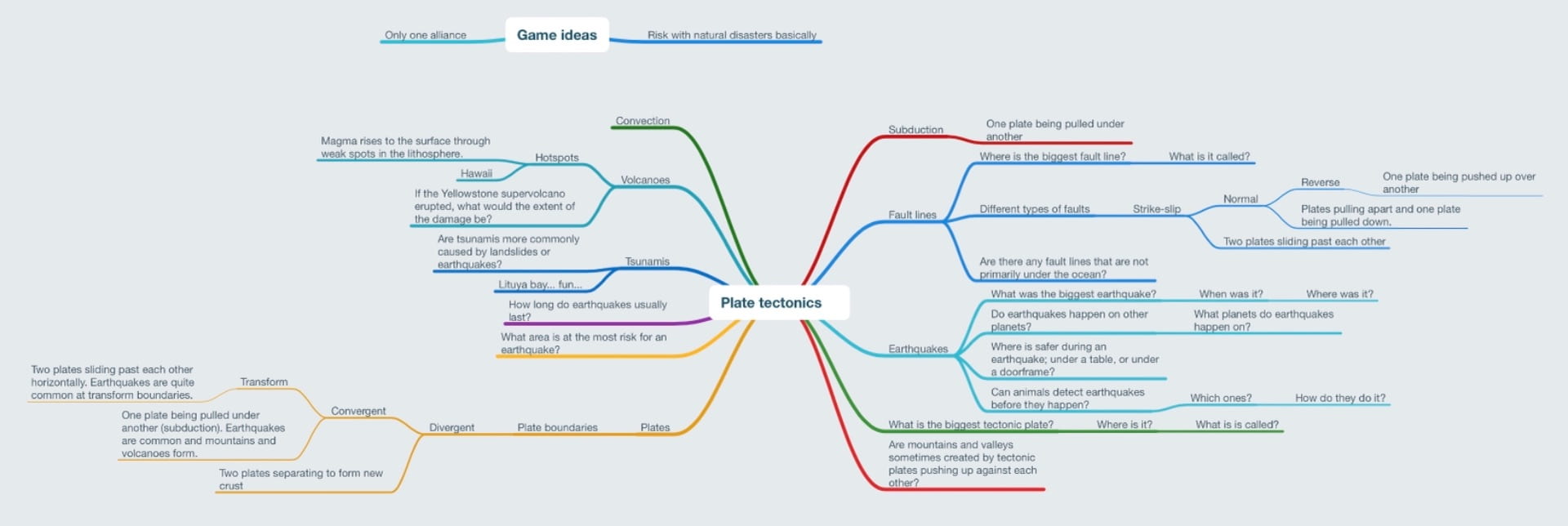Hello everyone! It’s me again. In this unit in Scimatics, we looked at plate tectonics and probability. I learned quite a bit. I feel like we primarily focused on tectonics, but we did some cool things with probability too. We also found ways to combine the two, hence the name ‘Tectonic Chances’.
The driving question of this unit was “How are thematic and mathematical elements used in game design?”. We were quickly given a way to find out about this when we were assigned to design and make a board game using the tectonics concepts that we have been learning. The groups were almost the same as the groups from our last unit. In this unit, I worked with Santiago, Julian and Max. I will link their blogs at the end of this post.
We also made mind maps about some of the things we were learning. In my mind map, I focused more on plate tectonics than game design. I kind of forgot to edit my mind map throughout the project and only edited it maybe three times. It’s a great way to organize your thoughts too, and I even used it to plan how I would design my family tree for a French project. My tectonics mind map ended up looking like the New York City transit map and I will definitely use the program (MindNode) again. Here is my mind map:
You can kind of see what I wrote before we started getting into lessons and what I wrote at the end of the unit.
Our board game was primarily based on using dice. All of the disasters were determined by the sums of rolling two dice. The game in itself was quite complicated, but it was fun to make. This is also how we combined plate tectonics and probability. Also, we put some examples of how probability is used in our game. Thematic elements change how a game is designed quite a bit. For example, the theme of our game is plate tectonics. That changed a lot of the rules and altered the gameplay. Originally, our game was going to be more focused on combat and fighting other people and taking over territories. Kind of like Risk with tectonics mixed in. But along the way, we realized we needed to change the dynamic of our game from “Risk with tectonic elements mixed in” to “tectonics with Risk elements mixed in”. This was actually kind of disappointing because it’s a lot more fun to design combat games than science games.
How I used or improved each curricular competency
Evaluating
Our game used the theory of plate tectonics and we had ten key science concepts in use. Our game was centred around plate tectonics.
Questioning and predicting
I found this unit to be very interesting. I showed curiosity about the science concepts we focused on. I feel like I could have been a little more focused at times but I am quite proud of my participation in the project. Our game actually turned out to be better than I thought it would be.
Understanding and solving
Our game showed mathematics concepts clearly in the game design. Our game rules also include examples of the probability of different things happening in our game. This shows understanding of key mathematical concepts. The probability in each turn can result in different outcomes.
So in conclusion, I really enjoyed this unit. I learned quite a bit about both plate tectonics and probability. Making a game was really fun and I feel like I followed the curricular competencies well.
I hope you enjoyed all 629 words of this post, and I’ll see you next time.
Bye!
Dylan
Game rules:
Santiago’s blog:
http://www.blog44.ca/Santiagov/
Julian’s blog:
Max’s blog:


January 3, 2021 at 2:32 am
I found it quite enjoyable to read your post. The way you explain your journey through was detailed.
Great job 😀
December 2, 2021 at 8:18 pm
You wrote this article very well. Very knowledgeable. Thanks for sharing this article
Visit dreamteach.co.uk!